Fitness Assessments
Cardiovascular Endurance
Cardiovascular endurance is related to the total body’s ability to maintain exercise for a prolonged period.
Cooper 12-Minute Test
This submaximal test measures your aerobic capacity through the distance you can cover in a twelve-minute period. Submaximal tests are tests that have protocols where the participant does not meet their maximal cardiovascular or respiratory system capacities. In short- do not go all out for this assessment. The objective of this assessment is to cover as much distance as possible in 12 minutes. This test can be completed by running at the fastest pace that is safe and feasible for you in this submaximal zone. The distance you cover can be used with an equation to estimate your VO2Max (mL/kg min). VO2Max is the maximum amount of oxygen that your body can use during exercise. It is a great indicator of cardiovascular endurance, which is the efficiency for your body to deliver oxygen and blood to your body during exercise and can serve as a benchmark to achieve while exercising.
Equipment: treadmill with 1 degree incline, a 200-meter track or 400-meter track (so distance can be measured), and a timer. A partner to time this test may be helpful.
- Note: 4 laps on a 400-meter track is 1 mile
Procedure:
- Start with a low intensity, 10 to 15-minute cardio warmup (such as walking, biking, or elliptical)
- When you’re ready to begin the test, start the timer. Run at the fastest pace possible while keeping track of laps completed and time elapsed. It would be helpful to have someone else track this for you if completing on a track.
- This assessment is measuring how far you can go by running. If you need to walk or stop to take a break, do so as needed, but keep the timer going.
- When finished, record the distance completed in meters. If on the treadmill, the distance may be given in miles. To convert the distance, there are 1609.34 meters in 1 mile. Calculate by multiplying the number of miles completed by 1609.34 to get the distance in meters.
You can check what category you fall into based on the distance you covered, your age, and gender:
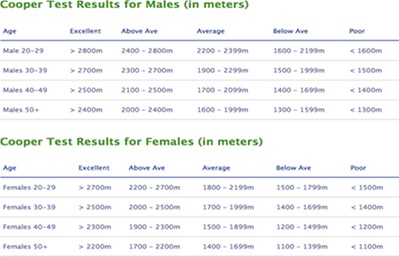
Source: “Cooper 12-Minute Run Test Norms.” Top end Sports, Science, Training and Nutrition
Muscular Strength
Muscular Strength for Abdominals: Sit Up Test
This test measures your ability to use your abdominal muscles and hip flexors to lift a lighter weight for a longer period time, or for more repetitions. In this test, you will perform as many sit ups, in good form, in one minute. Having a strong core is pertinent for good posture and back support.
Equipment: a mat and a timer
Procedure:
- Start by laying down on your back on the mat, with your knees and feet flat on the floor. Hands should be placed on your thighs.
- By engaging your core, lift your upper body up only until your shoulder blades are off the ground. Slide your hands up your thigh to touch your knees, then lower yourself back down to the mat.
- Keep your lower back on the mat and don’t strain your neck during this exercise.
- Repeat as many times as possible for one minute while keeping this form. Take a break if you need to but keep the timer running throughout.
| Starting Position: | Ending Position: |
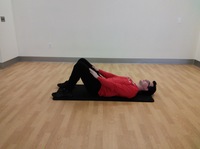
|
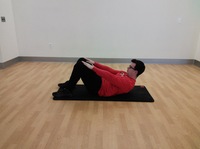
|
You can check what category you fall into here based on how many repetitions you or a partner counted:
Muscular Strength for Chest: Push Up Test
This test measures upper body strength, specifically in the chest and biceps. Unlike endurance, this tests your ability to lift a heavier load for a shorter duration. It is done by seeing how many pushups you can complete in a row without losing good form within two repetitions, resting, or falling to the ground.
Equipment: a mat
Procedure:
- Subjects must start in the down position. Women will do the modified push-ups on their knees and men will do them elevated on their toes.
Good form in the down position for men consists of:
- Hands facing forward
- Hands placed underneath shoulders
- Back straight
- Head up
- Glutes in line with the body
- Toes as a pivotal point
| Up Position: | Down Position: |

|

|
Good form in the down position for women consists of:
- Legs together
- Lower leg in contact with the mat
- Hands facing forward and shoulder-width apart
- Back straight
- Knees as a pivotal point
| Up Position: | Down Position: |
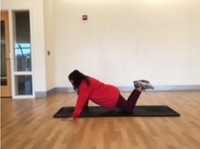
|

|
- Push up until your arms are straight and extended, maintaining good form.
- Slowly lower yourself back into the down position, being sure to touch your chin to the mat but not your stomach.
- For men and women, back must be flat and glutes must be in line with the body.
- Complete in a mirror to check your form if needed.
See what category you fall into based on the number of push-ups completed, gender, and age:
Muscular Imbalances
Overhead Squat Assessment
The objective of this test is to see if there are any muscular imbalances where overactive or underdeveloped in your body could be affecting certain lifts, movements, or postures.
Equipment: another person to assess the movement
Procedure:
*In order to complete a true assessment of this, do not provide any cues as to how to do a squat properly but just to put their arms up overhead. This way, the subject will not correct any of the imbalances.
- Sit into a squat and raise your arms overhead to where it feels natural.
- Hold the position as the other person walks around and looks at them from 3 different perspectives: anterior, lateral, and posterior (the front, side, and back)
- The person walking around should be looking for certain incorrect aspects of the position as they are analyzing the squat.
- Check off imbalances noticed below and reference the table explaining what muscles are affected.
This is what the correct squat form should look like.
Anterior:
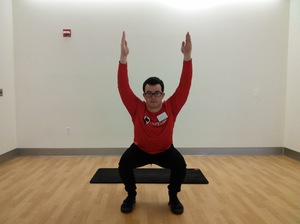
Note: Feet facing forward, knees in line with hips and knees in line with ankles
Lateral:
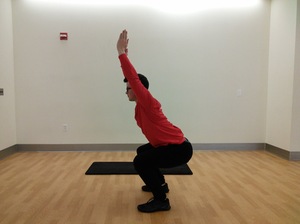
Note: back straight, arms fall in with hips, and keep knees behind toes
Posterior:

Note: feet flat on the floor, back straight, and even weight distribution between legs
*Nothing may be checked off on this list at all, which means that there were no muscular imbalances observed during this assessment.
Check off below if any of the following are noticed:
Anterior view:
_______ feet turn out
_______ knees move inward
_______ knees move outward
Lateral view:
_______ low back arches
_______ low back rounds
_______ excessive forward lean
_______ arms fall forward
Posterior view:
_______ heels rise off floor
_______ asymmetric weight shift
_______ excessive forward lean
_______ back arched
If any of these items were checked off, you can look at the table below and see what specific muscle groups are either underactive or overactive. As you can see, an imbalance can result from either a muscle that is too strong and needs to be stretched out more or an underactive muscle that needs to be strengthened. In order to fix the imbalance, it is recommended that you do both strengthening and stretching of the corresponding muscle groups.

Source: “Personal Training & Fitness Certifications” NASM
Muscular Endurance
Plank Test
Having a strong core is an essential part of having a healthy body, as it helps you maintain proper posture and safe form during activities. This tests the endurance mainly of your rectus abdominis and external obliques, or the main abdominal muscle. It additionally tests your total body strength and endurance. The test can be completed by holding a plank position with correct form for as long as possible.
Equipment: a level surface, timer, and another person to assess form
Procedure:
- Elevate your body by balancing on your forearms and toes. Your body should be straight in alignment and flat, with hips lifted off the floor. Using a mirror will help check this.
- Weight should be supported on the toes and forearms or hands. Your back should be flat, and glutes should remain in line with the body.
- Once in correct position, have the other person start the timer and see how long you can hold the plank in good form.
- Stop the timer if you drop your hips or body to the floor, hip or back raises up or lowers below flat, or you must change position at any point.
| Forearm plank: | High plank: |

|
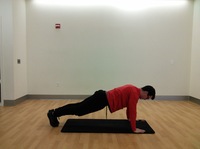
|
Once you have completed the plank test, here is a table where you can see what category you fall in based on time held, gender, and athletic ability. As you can see below, the non-Varsity category means you do not have much experience in athletic ability whereas in the Varsity category, you do. Place yourself accordingly:
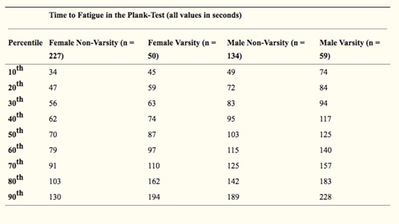
Source: Strand et. Al., "Norms for an Isometric Muscle Endurance Test"
Flexibility
Flexibility is the ability to move a joint through its complete range of motion (ACSM, 2021).
Shoulder Flexibility
Even when we are gaining strength, it is important to make sure that our joints and muscles stay flexible to prevent injury and allow us to function during everyday activities. This test measures the flexibility of your shoulder joint, which is a crucial component in many upper body exercises. This test will help show if you are losing range of motion due to lack of flexibility or high muscle mass.
Equipment: tape measure or ruler and another person to read the measures
Procedure:
- Stand up and make sure you have some room around you to move your arms.
- Start with your left arm. Raise your left arm straight up overhead.
- Bend your left elbow down and let the palm of your hand touch your back.
- Slide your hand and arm as much as you can down your back.
- With your right hand, bend your elbow so that the back of your hand is touching your back.
- Slide both your right and left hand towards each other, as much as you can until they touch or are close to.
- Have the other person take the ruler and measure the distance between your hands, if there is any.
- Switch your hands so that the right is overhead, and left is under. Record the distance between your hands in inches.
- Repeat it 3 times and get the average for each hand by adding up all three measurements and then dividing it by three.

|

|
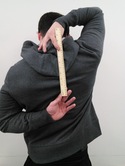
|
Here is a table (in inches) that you can use to find your ranking of shoulder flexibility based upon your age, gender, and distance separating your hands:

Source: “Back Scratch Test.” Top end Sports, Science, Training and Nutrition
If you wish to assess your flexibility in other joints, here are some stretches that test the range of motion for many joints and the majority of major muscle groups. Static stretches are held in a still position, while dynamic stretches involve movement through the stretch. Flexibility can be measured in many ways that may require equipment, but there are a few simple questions that you can ask yourself to assess if your flexibility allows joints to go through a proper range of motion- Can you touch your toes when standing? Can you turn your head to look over each shoulder? Can you touch in-between your shoulder blades when you reach one arm up and overhead at a time? If you answered no to these questions, then you should think about incorporating more flexibility work into your routine!
Cross Body with each arm (static)

|

|
Overhead stretch using a towel or band between hands (static)

|

|
Rotating shoulders forward and backwards (dynamic)

|

|

|
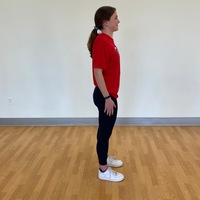
|
Arms overhead and leaning left and right while pushing up (static)

|

|
Goal post with a band or bar (dynamic)
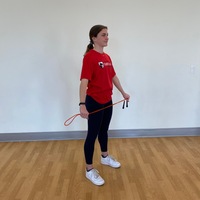
|
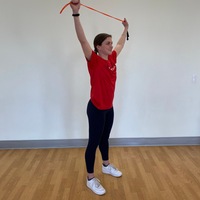
|
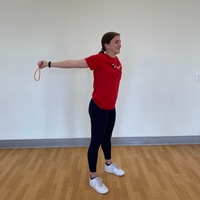
|

|
Y stretch against a wall (static)
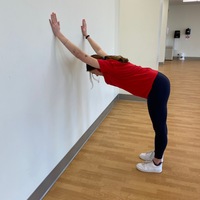
|
Bode Composition Measurement
BMI
Body Mass Index (BMI) is a person’s weight in kilograms divided by the square of their height in meters. It is one of the most commonly used screening methods to identify one’s weight category. It is inexpensive and relatively easy to determine. The BMI weight categories are broken down into underweight, healthy weight, overweight, and obesity (CDC)
BMI does not measure body fat directly, but BMI is moderately correlated with more direct measures of body fat. To determine if BMI is a health risk, a healthcare provider can perform further assessments.
Here is a table from the Centers of Disease Control (CDC) listing the adult BMI categories, broken into height (inches) and weight (pounds) intervals that you can use to determine your BMI.

Source: “Body Mass Index Table 1.” National Heart Lung and Blood Institute, U.S. Department of Health and Human Services


